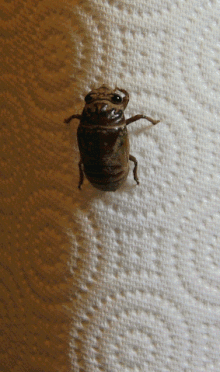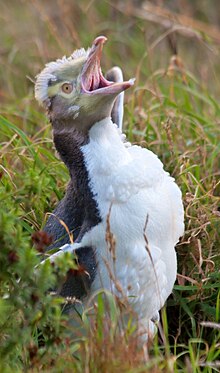Moulting

In biology, moulting (or molting,[1] also known as sloughing, shedding or for some species, ecdysis) signifies the manner in which an animal routinely casts off a part of its body (often but not always an outer layer or covering), either at specific times of year, or at specific points in its life-cycle.
Moulting can involve the epidermis (skin), pelage (hair, fur, wool), or other external layer. In some species, other body parts may be shed, for example, wings in some insects. Examples include old feathers in birds, old hairs in mammals (especially dogs and other canidae), old skin in reptiles, and the entire exoskeleton in arthropods.
Examples
| Species | Item shed | Timing | Known as | Notes |
|---|---|---|---|---|
| Dogs and other canids | Hair (Fur) | Semi-annually, spring and fall (autumn) | Shedding | Moulting in canids , as in all mammals[2], is thought to be due to fluctuations in the amount of melatonin secreted by their pineal gland in response to seasonal sunlight variations. It has nothing to do with seasonal temperature variations. This seasonality in shed pattern is most preserved in Arctic breeds of dogs that shed twice a year,[3] other breeds now shed year round. |
| Snakes | Skin | Regularly, when old skin is outgrown | Moulting | Snakes will rub against rough surfaces to shed their skin. |
| Lizards | Skin | Regularly, when old skin is outgrown | Moulting | Lizards consume their shed skin for calcium, grooming, and other nutrients |
| Hermit crabs | Exoskeleton | Regularly, when the carapace is outgrown | Moulting | Land hermit crabs bury themselves for many weeks while they moult and consume their exoskeleton. |
Specific species notes
Birds

|

|
| A Loggerhead Shrike in mid-moult (left) compared to one with regular plumage (right). | |

In birds, moulting is the periodic replacement of feathers by shedding old feathers while producing new ones. Feathers are dead structures at maturity, and they become gradually worn down and need to be replaced. Adult birds moult at least once a year, though many moult twice, and a few three times.[4] It is a comparatively slow process, as a bird never sheds all its feathers at once; it must keep enough of its feathers to regulate its body temperature and repel moisture. The amount of shed feathers varies. In some moulting periods, a bird may renew only the feathers on the head and body, shedding the wing and tail feathers during a later moulting period.[4] Some species of wild bird become flightless during an annual "wing moult" and must seek protected habitat with a reliable food supply during that time. While plumage may look thin or uneven during moult, the general shape is maintained despite the loss of apparently many feathers; genuine bald spots are typically signs of unrelated illnesses, such as gross injuries, parasites, or (in pet birds) feather plucking.
The process of moulting in birds is as follows: First, the bird begins to shed some old feathers, then pin feathers grow in to replace the old feathers. As the pin feathers become full feathers, other feathers are shed. This is a cyclical process that occurs in many phases. It is usually symmetrical, with feather loss equal on each side of the body.[4] Because feathers make up 4-12 percent of a bird's body weight, it takes a large amount of energy to replace them. For this reason, moults are frequently timed to occur right after the breeding season, but while food is still abundant. The plumage produced during this time is called postnuptial plumage.[4]
Dogs
Dogs shed their fur twice a year, in the spring and fall, or more often, depending on breed, living environment, and temperature. The shedding of dogs is never called "moulting". As dogs live with humans, the topic of dog shedding is of more immediate interest to the average pet owner than the shedding cycles of wild canidae. Wikipedia articles on individual dog breeds may contain more information on the shedding cycle of a particular breed.
The following is a list of breeds that are alleged by a pet website to have little or no shedding, but no proof or research is cited. Such breeds are often claimed to be hypoallergenic, but relying on such information can prove dangerous to an allergic person.[5] The same pet website page from which the following list was obtained clearly states "All dogs shed".[6]
Reptiles


The most familiar example of moulting in reptiles is when snakes "shed their skin". This is usually achieved by the snake rubbing its head against a hard object, such as a rock (or between two rocks) or piece of wood, causing the already stretched skin to split. At this point, the snake continues to rub its skin on objects, causing the end nearest the head to peel back on itself, until the snake is able to crawl out of its skin, effectively turning the moulted skin inside-out. This is similar to how one might remove a sock from their foot by grabbing the open end and pulling it over itself. The snake's skin is often left in one piece after the moulting process. Conversely, the skin of lizards generally fall off in pieces.
Arthropods
In arthropods, such as insects, arachnids and crustaceans, moulting is the shedding of the exoskeleton (which is often called its shell), typically to let the organism grow. This process is called ecdysis. Ecdysis is necessary because the exoskeleton is rigid and cannot grow like skin. The new exoskeleton is initially soft but hardens after the moulting of the old exoskeleton. The old exoskeleton is referred to as an "exuvium" (or exuvia).
Humans
While humans do not strictly molt, an important part of the skin's defense against fungi is stratum corneum turnover that removes the microbe by shedding the old skin surface. This is increased by the immune system detection of dermatophytes (skin living fungi) such as Trichophyton rubrum.[7]
External links
References
- ^ "Molting" vs. "moulting" -- see spelling differences.
- ^ Characterizing a Mammalian Circannual Pacemaker
- ^ Hair Loss in Dogs - Why Is My Dog Loosing It’s Hair? Alopecia X
- ^ a b c d Terres, J. K. (1980). The Audubon Society Encyclopedia of North American Birds. New York, NY: Knopf. pp. 616–617. ISBN 0394466519.
- ^ Nonallergenic Dog? Not Really by Denise Grady, New York Times, February 5, 1997
- ^ Go Pets America: Dogs that do not shed - Retrieved September 7, 2008
- ^ Dahl MV. (1993).Suppression of immunity and inflammation by products produced by dermatophytes. J Am Acad Dermatol. 28(5 Pt 1):S19-S23. PMID 8496406

